Since the United States declared its independence in 1776, the Stars and Stripes have symbolized freedom and democracy on the world stage.
(Side note: We may not always agree with whoever?s on the other side of the aisle. But we?re able to express our sentiments, agreeable or otherwise, openly ? a privilege afforded to few.)
The American flag has had many different looks over the last 240-plus years. Each time a new state was admitted into the Union, flag designers had to make appropriate adjustments.
Why?
A brief primer:
1. The stripes represent the 13 original colonies of the United States
2. The stars represent each state of the Union
A book published by the House of Representatives in 1977 describes the symbolism of the flag as follows:
The star is a symbol of the heavens and the divine goal to which man has aspired from time immemorial; the stripe is symbolic of the rays of light emanating from the sun.
What about the colors?
According to Charles Thompson, secretary of the Continental Congress:
- Red signifies hardiness and valor
- White signifies purity and innocence
- Blue signifies vigilance, perseverance and justice
While the flag?s colors have stayed the same and ?except for the 15-stripe Star Spangled Banner Flag, which flew from 1795 to 1818? there?s always been 13 stripes on it, the number of stars has changed several times over the course of U.S. history as more territories became states.
Here?s an image that shows the various iterations of the American flag, both formal and informal:
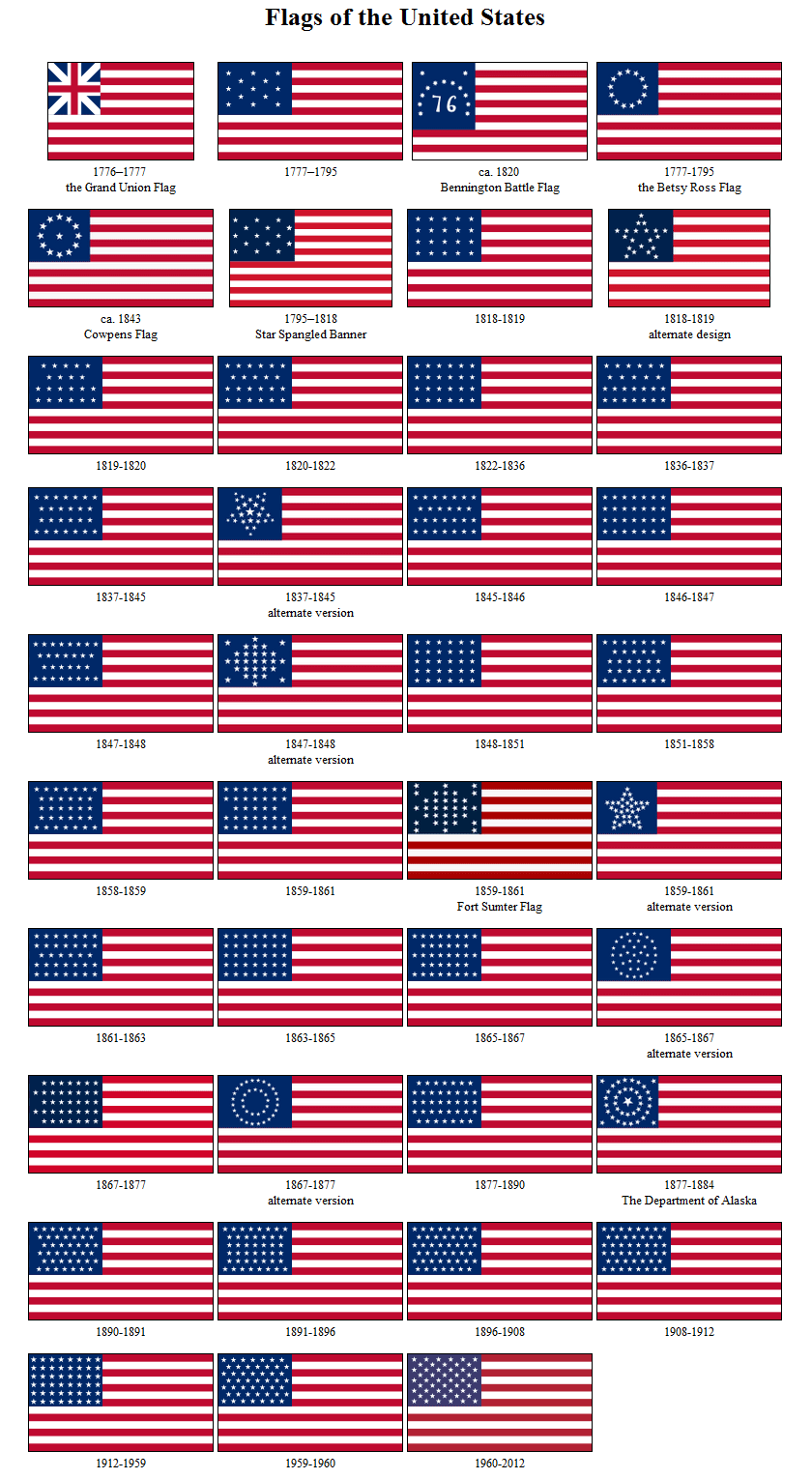 A list of the known iterations of the American flag. (source)
A list of the known iterations of the American flag. (source)
(For an even more extensive collection of old American flags, check this out.)
The American flag last changed in 1960 to celebrate Hawaii?s statehood. Though Hawaii became a state on August 21, 1959, new flags have been formally adopted on Independence Day, July 4, since 1818.
Which means that the current iteration of the U.S. flag has lasted longer than any of its predecessors.
Here are the three runner-ups:
- The 48-star flag | 47 years | (1912?1959)
- The 15-star flag | 23 years | (1795?1818)
- The 13-star flag | 18 years | (1777?1795)
Crunch the numbers and you?ll see that the average American flag flies for nine years.
Math tells us we?re long overdue for a change.
Will there ever be fewer stars on the flag?
Let?s hope not.
Unless the United States endures another Civil War ? and whichever group of states chooses to secede wins ? it?s hard to imagine a scenario where there are fewer stars on the flag.
It?s unlikely New Hampshire and Vermont, for example, would ever choose to merge into a single state.
The resulting Verhampshire would only have two senators, which would lessen the region?s influence in Washington. (Remember that, thanks to the ?Connecticut Compromise,? each state is guaranteed two senators ? no more, no less.)
There?s been a lot of talk of California leaving the Union lately.
But is a ?Calexit? likely?
Doubtfully.
According to the Constitution, there isn?t a legal way for a state to secede.
So, absent an amendment that grants California the right to leave and take its world?s sixth-largest economy along for the ride, it is extremely unlikely that the federal government would ever allow the state to become an independent country ? petitions be damned.
And, even if a Calexit happened, what would become of places like Yosemite National Park and Joshua Tree National Park?
What would happen to the state?s water supply?
Of course, public sentiment could shift overwhelmingly and the Union could shrink ? peacefully even.
Time will tell.
 An American flag with 48 stars. (source)
An American flag with 48 stars. (source)
OK, so will more stars be added to the flag?
Assuming the flag ever changes, it?s likely more stars will be added.
It?s long been rumored that Puerto Rico, currently a U.S. territory with commonwealth status, is the most likely candidate to become the 51st state.
But voters there seem to be more interested in remaining a commonwealth ? or becoming an independent nation.
There?s also the curious case of the District of Columbia, Washington, D.C.
The city?s license plates display the phrase ?taxation without representation? to reflect the fact that D.C. lacks direct representation in Congress ? something that?s long bothered D.C. residents.
In November 2016, 79% of voters voiced their desire to see D.C. admitted into the Union as the 51st state: New Columbia.
 New Columbia Statehood Commission (source)
New Columbia Statehood Commission (source)
Despite these results, many critics still believe statehood is unlikely anytime soon.
According to a 1953 congressional committee, the requirements of statehood include adherence to the values of democracy, an electorate that wants statehood and one that has the monetary means to afford it.
D.C., with its $100 billion-plus GDP, seems to meet the criteria.
But alas.
As for other U.S. territories becoming states? Don?t count on it.
Some of Guam?s residents, for example, have been clamoring for independence of late. American Samoans say other priorities, like economic development, are more important than pursuing statehood.
Even if citizens of the various U.S. territories wanted statehood, the Supreme Court has already ruled against their claims to self-determination.
Since it doesn?t seem like there will be a new state will be added to the Union anytime soon, does that mean we?re stuck with the 50-star flag forever?
Not necessarily.
Over the years, New York has seen many proposals for subdivision.
In 1969, writer Norman Mailer ran for mayor of New York City, pledging that ? if elected ? the city would secede from New York State, becoming America?s 51st state.
More recently, residents of northern New York have expressed their desire to form the state of New Amsterdam.
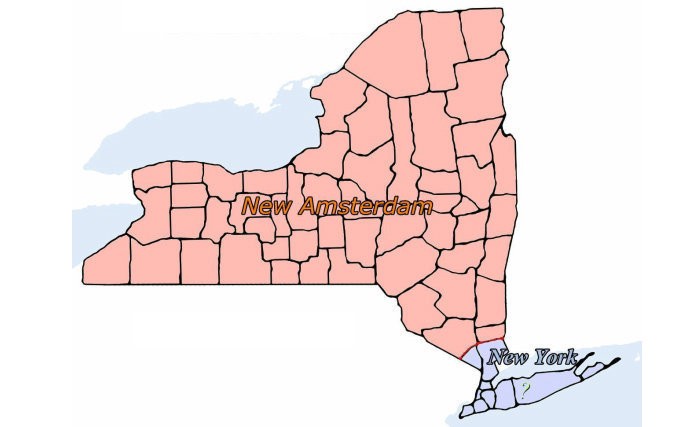 A proposal to split New York into two states. (source)
A proposal to split New York into two states. (source)
In 2011, on the other side of the country, concerned citizens in Arizona proposed splitting the Grand Canyon State in two in response to an immigration bill passed by then-Governor Jan Brewer.
The movement has stalled since then, but here?s what the newly formed state of Baja Arizona might have looked like:
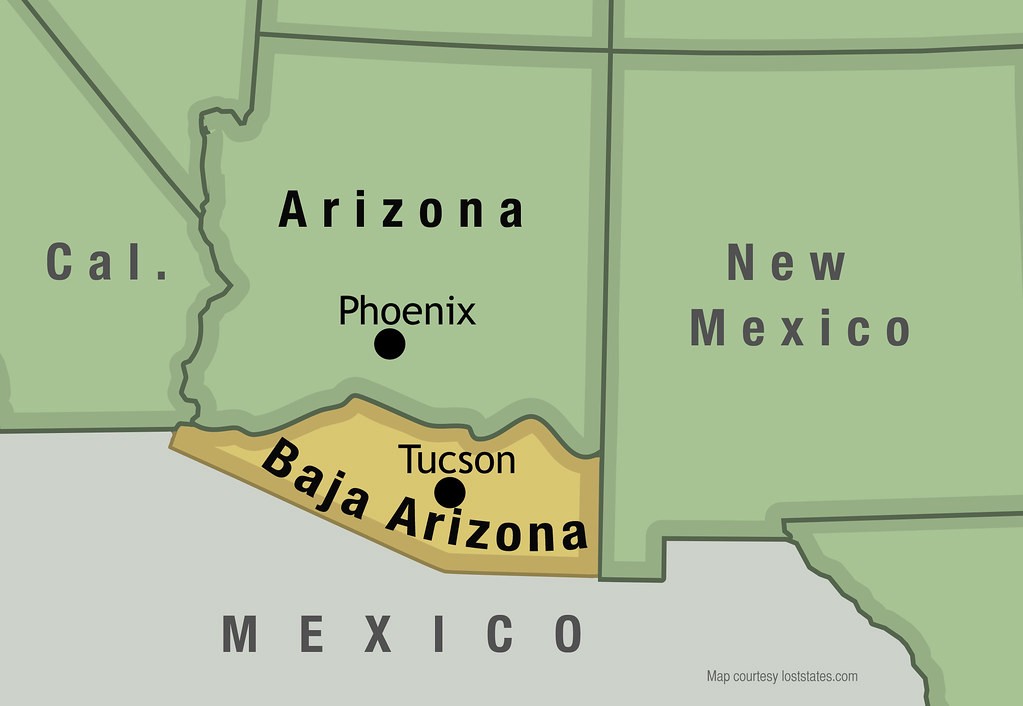 A proposed division of Arizona. (source)
A proposed division of Arizona. (source)
Two years later, residents of northern Colorado considered forming the new state of North Colorado.
At the time, pundits speculated that breaking The Centennial State up might actually be financially beneficial for Colorado itself; the newly formed North Colorado, however, would have been the smallest state in the Union, populated by only 350,000 people who earned a median income of $24,000.
In any case, voters ended up rejecting the split when they weighed in on the issue in November 2013.
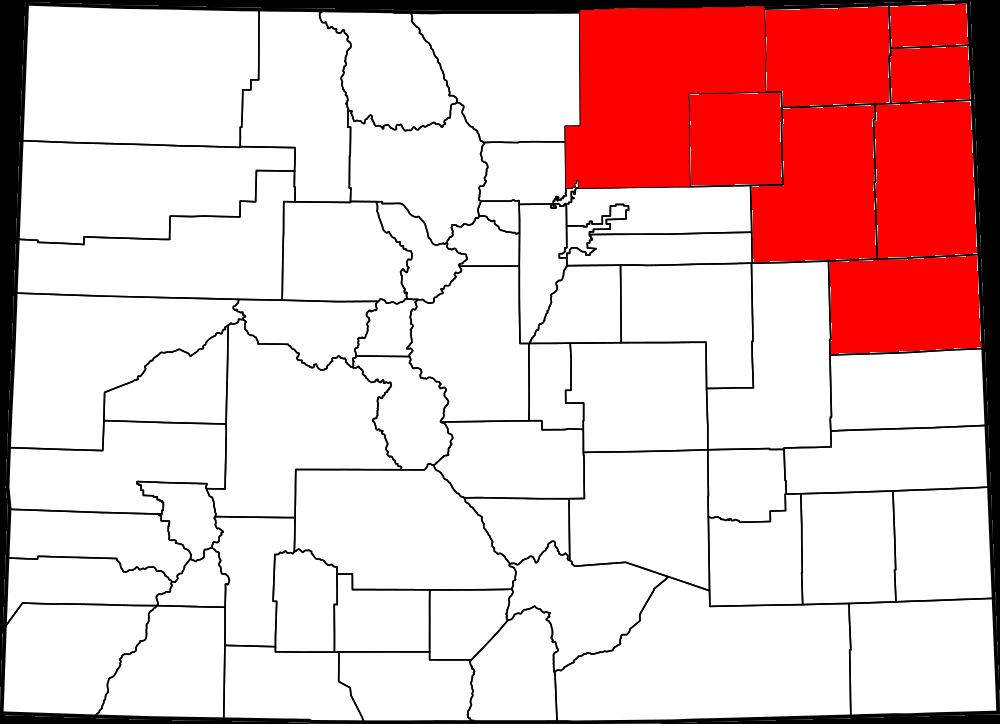 Colorado in white and one proposal of North Colorado in red. (source)
Colorado in white and one proposal of North Colorado in red. (source)
And check this out: Texas reserves the right to split into five separate states due to a quirk in an 1845 congressional resolution.
Here?s some background from Smithsonian:
Article IV, Section 3, of the U.S. Constitution states that Congress must approve any new states. But Texas? claim to an exception comes straight from the 1845 joint congressional resolution admitting Texas into the Union. It reads: ?New States of convenient size not exceeding four in number, in addition to said State of Texas and having sufficient population, may, hereafter by the consent of said State, be formed out of the territory thereof, which shall be entitled to admission under the provisions of the Federal Constitution.? Supporters of Texas division say this means that Congress pre-approved a breakup.
It?s still far-fetched. But what might a split up Texas look like?
Nate Silver of FiveThirtyEight offers a possibility:
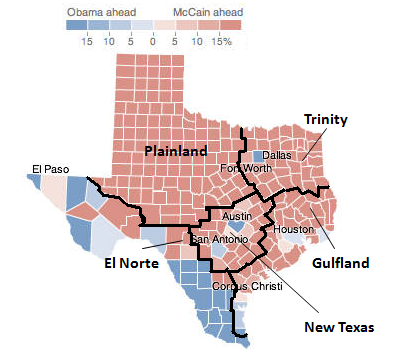 Nate Silver?s prediction of what a subdivided Texas might look like. (source)
Nate Silver?s prediction of what a subdivided Texas might look like. (source)
While California lacks Texas? ?legal authority? to divide itself, it may still decide to break into at least two states.
There?s precedent for this happening: Kentucky broke off from Virginia in 1792; Maine broke off from Massachusetts in 1820 under the Missouri Compromise; West Virginia broke off from Virginia in 1863; and the Dakota Territory broke into North Dakota and South Dakota in 1889, when both states joined the Union.
So, one day, California may become two states.
Or even six.
In 2013, billionaire Tim Draper launched the Six Californias campaign, which proposed splitting the Golden State into six smaller states.
Organizers, however, were unable to get enough signatures for the motion to be considered during the 2016 election cycle.
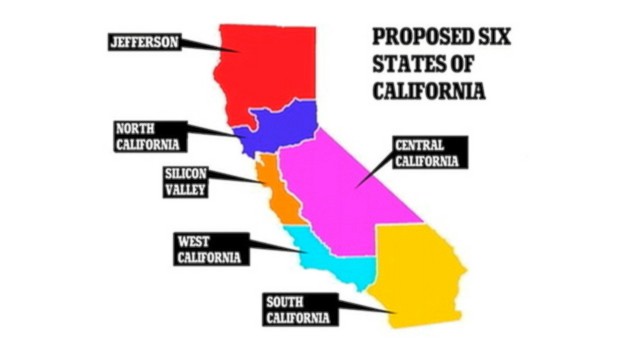 The Six Californias campaign lacked enough support to qualify as a ballot measure. (source)
The Six Californias campaign lacked enough support to qualify as a ballot measure. (source)
Just because that campaign failed doesn?t necessarily mean California will remain unified.
Residents of Modoc and Siskiyou Counties in northern California have submitted petitions to form the independent state of Jefferson. And, more recently, residents from the state?s more rural counties announced their intention to split California into two states: California and New California.
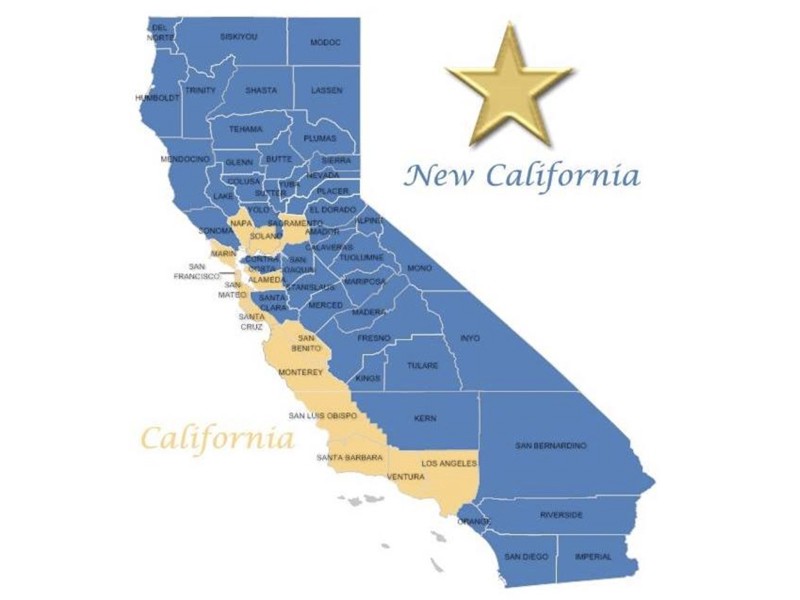 There?s an effort underway to divide California into two states. (source)
There?s an effort underway to divide California into two states. (source)
Draper hasn?t given up, either.
In April 2018, the billionaire announced that his new proposal ? which would split California into three states ? received more than enough support to face the voters in an upcoming referendum.
In June 2018, election officials said the measure would be included on the November 2018 ballot.
In July 2018, however, the California State Supreme Court unanimously ruled that the measure wouldn?t face voters during the 2018 cycle. Further legal arguments were necessary, the court said, to ensure the validity of the proposition. The courts will ultimately decide whether to bring the issue to the voters in 2020.
In any case, if Draper?s latest plan is backed by the voters at some point in the future? and Congress approves ? the states of California, Northern California and Southern California might look like this:
 Will California be split into these three states? (source)
Will California be split into these three states? (source)
(There have been several other proposals to break up California over the years. Read about them here.)
Moving north, lawmakers in Washington have proposed splitting the Evergreen State down the middle, with the eastern portion becoming the new state of Liberty.
 Will Washington split into two states? (source)
Will Washington split into two states? (source)
It?s the seventh time in the state?s history that division has been discussed.
Those in favor of the current proposal say Liberty would be a rich state driven by the agriculture and energy industries. Those opposed say Liberty would suffer from the absence of Microsoft, Boeing and Amazon?s tax revenues.
(Head here for even more instances of states considering subdivision over the course of U.S. history. Some of the most notable statehood proposals include Absaroka, Deseret, Westsylvania and Superior.)
For the foreseeable future, it appears the American flag will retain its 50 stars.
But all of us can agree we live in interesting times, so who knows what the future holds.
Should any of these moonshot proposals ever gain enough traction?and, while unlikely, it?s not impossible ? the 51-, 52- or 54-star flag will finally fly.
What do you think?
Will it happen?
If so, when?
Or will 50 prove to be a perfect number for America?
Connect with me on Twitter and LinkedIn.


